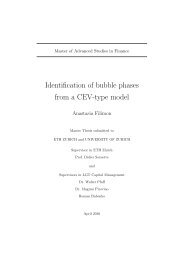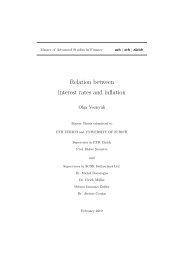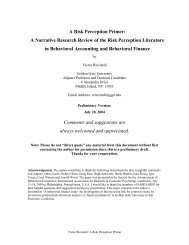Tail Dependence - ETH - Entrepreneurial Risks - ETH Zürich
Tail Dependence - ETH - Entrepreneurial Risks - ETH Zürich
Tail Dependence - ETH - Entrepreneurial Risks - ETH Zürich
You also want an ePaper? Increase the reach of your titles
YUMPU automatically turns print PDFs into web optimized ePapers that Google loves.
and L(y), assumed to be constant for y > k, is estimated by:<br />
ˆL(y) = k<br />
N<br />
· (Yk,N) ˆν<br />
(3.10)<br />
with Y1,N ≥ Y2,N ≥ · · · ≥ YN,N denoting ordered statistics of the sample containing N<br />
independent and identically distributed realizations of the market return vector Y and<br />
k denoting the number of the threshold value representing the least extreme value still<br />
counted to the tail of the distribution.<br />
Ledford and Tawn [12] (1996) characterized the joint tail behavior by constant η<br />
denoting the coefficient of tail dependence and slowly varying function L(s) and established<br />
that under weak conditions:<br />
Pr(S > s, T > s) ∼ L(s) · s −1/η<br />
with 0 < η ≤ 1. It follows from the representations in [15] (1999) that<br />
as s → ∞ (3.11)<br />
χ = 2η − 1<br />
⎧<br />
⎨ c if χ = 1 and L(s) → c > 0 as s → ∞<br />
(3.12)<br />
χ = 0 if χ = 1 and L(s) → 0 as s → ∞<br />
⎩<br />
0 if χ < 1<br />
(3.13)<br />
χ = 1 corresponds to η = 1 and yields χ = lims→∞ L(s). Thus the estimation of η<br />
and lims→∞ L(s) provides the basis for the estimation of χ and χ. According to the<br />
modeling assumption for the bivariate case, for Z = min(S, T):<br />
Pr(Z > z) = Pr (min(S, T) > z)<br />
= Pr(S > z, T > z) (3.14)<br />
= L(z) · z −1/η<br />
for z > Zk,N<br />
for some high threshold number k. As η is the tail index of the univariate variable Z, it<br />
can be estimated by equation (3.9) using Hill’s estimator restricted to the interval (0, 1]<br />
and lims→∞ L(s) can be estimated using equation (3.10). The following estimators are<br />
based on the assumption of independent observations on Z. χ was estimated to:<br />
ˆχ = 2<br />
�<br />
k� � �<br />
Zj,N<br />
log<br />
k Zk,N<br />
j=1<br />
�<br />
− 1 (3.15)<br />
var � ˆχ � �<br />
ˆχ + 1<br />
=<br />
�2 (3.16)<br />
k<br />
The estimator of χ, only calculated if there is no significant evidence to reject χ = 1,<br />
was proposed to be:<br />
ˆχ = Zk,N · k<br />
N<br />
var(ˆχ) = Zk,N 2 k(N − k)<br />
N3 (3.17)<br />
(3.18)<br />
ˆχ is a figure that could be compared to other estimators of tail dependence coefficients,<br />
which are explained in the following sections of chapter (3) because it has the same<br />
underlying definition as provided in equation (2.33) showing the formula of upper tail<br />
dependence.<br />
14








